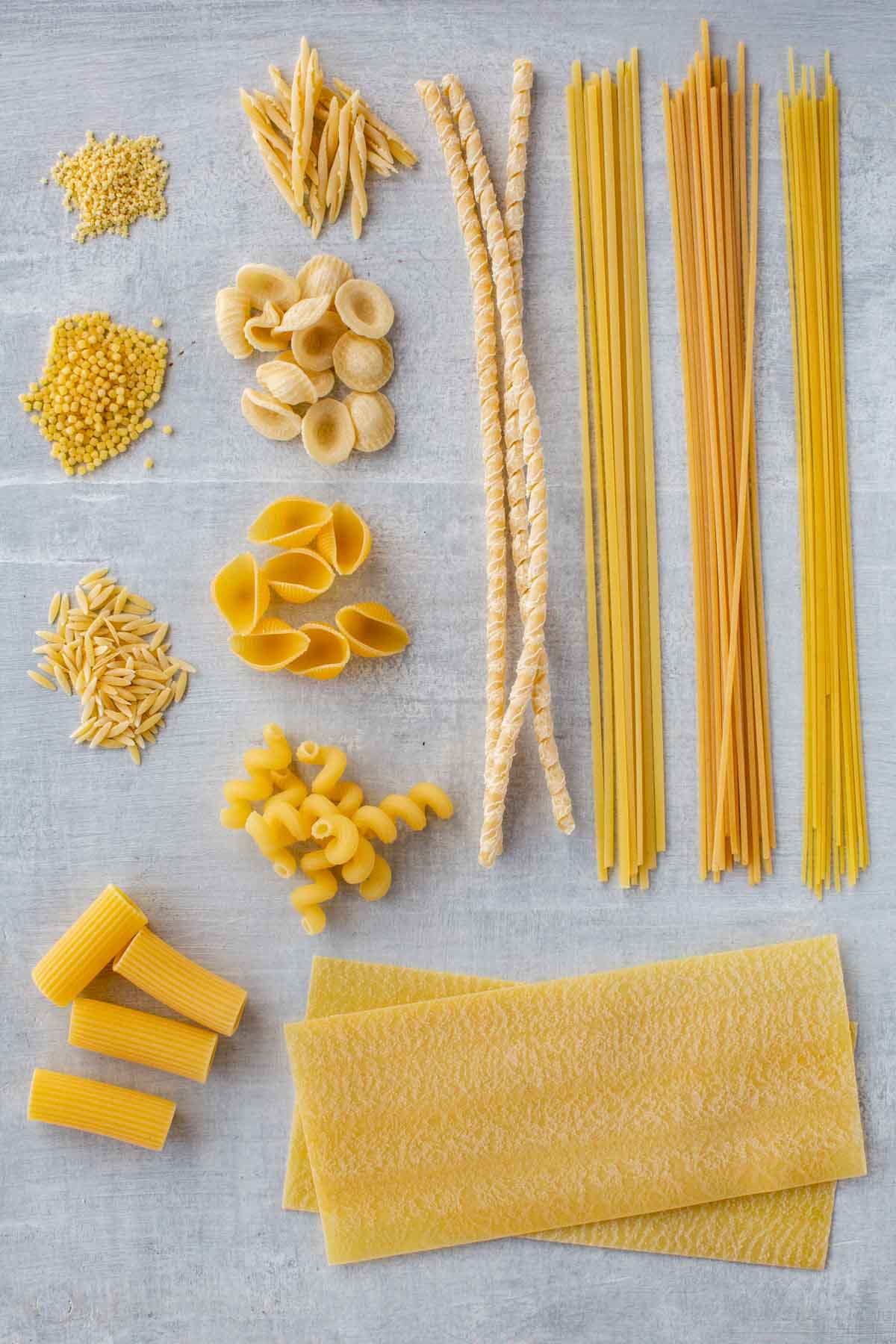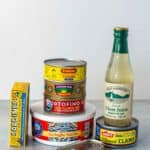Italian Dried Pasta
Italian dried pasta is more than just a pantry staple, it's a symbol of Italy's history and culture. And not all dry pasta is the same. The quality of water and wheat flour used, combined with the drying process, can give different quality results, which then can make or break a pasta dish. Learning to recognize authentic Italian pasta, will help you turn your pasta dishes into masterpieces.

There are more than 300 different pasta shapes in commerce in Italy, but only a handful are available worldwide, exported and sold by the biggest pasta brands. You may recognize the main brands like Barilla, but there are many more that are less known, and have higher quality pasta, like Rummo, De Cecco, Garofalo, or Di Martino.
It's no coincidence, in fact, that Italy is the world's leading producer and exporter of pasta. In Italy, over 62% of the population eats pasta every day, sometimes twice a day. Recently, the value of pasta exports reached €2.6 billion to the markets of Germany, UK, France, USA and Japan.
History and Culture
The origins of pasta are a topic of debate, but it's widely accepted that pasta has been a part of Italian cuisine for centuries. Some believe pasta was brought to Italy from China by Marco Polo in the 13th century, while others argue that it was already being made in Italy long before then. What we do know is that by the 14th century, pasta was already a staple in the Italian cuisine.
Initially, pasta was made fresh and consumed immediately. However, the drying pasta process slowly developed, making it possible to store for longer periods and transport it over long distances. By the 19th century, pasta production had become industrialized, making it an affordable and widely available food.
Types of Dried Pasta
Italian dried pasta comes in hundreds of shapes and sizes, each designed to pair with different sauces and ingredients. Here are some of the most popular shapes:
- Spaghetti: Spaghetti is perhaps the most famous pasta shape. Long, thin, and cylindrical. Spaghetti are available in different thickness, usually identified by a number (though it may vary by brand). Spaghetti alla chitarra, instead, are similar to spaghetti, but square-shaped instead of cylindrical.
- Penne: Penne is a tube-shaped pasta with diagonally cut ends. It can have either a ridged or smooth surface.
- Fusilli: Fusilli is a corkscrew-shaped pasta. The twists and turns of fusilli are great for trapping chunky sauces.
- Farfalle: Also known as "bow-tie" pasta, farfalle is a fun and very common shape. Also available in tiny format for soups, called Farfalline.
- Rigatoni: Rigatoni are large, ridged tubes that are great for heartier sauces. There are different varieties, changing the length and width of the shape.
- Linguine: Similar to spaghetti but flatter, linguine is often used with seafood-based sauces.
- Orzo: Orzo is a small, rice-shaped pasta often used in soups or salads. It’s a great addition to broths and stews because it cooks quickly and absorbs flavors well.
- Lasagna: Lasagna are wide and flat pasta sheets, traditionally used in layered baked Lasagna alla Bolognese. There are different types available: smooth, ridged, or spinach-flavored.
- Orecchiette: Orecchiette means "little ears" in Italian, and this small, round pasta shape is great for holding sauces. It's often paired with broccoli rabe and sausage in southern Italian cooking.
Quality and Authenticity
Authentic Italian dried pasta is made from durum wheat semolina, which gives the pasta its firm texture and ability to hold its shape during cooking. It's easier to rely on well-known quality brands to get the best pasta product, or use the tips below to test unfamiliar pasta brand.
Tips for Recognizing Authentic Italian Pasta
Recognizing the best Italian pasta is not difficult. So how do you recognize the quality of pasta? To begin with, you can do a little home test. Just pour the pasta into a container with water at room temperature and check that after a couple of hours the pasta has remained compact, without releasing too much starch into the water. If this happens, the quality is excellent. Another reliable indicator is the protein content. If it is between 12.5% and 15%, it means that the semolina used is good.
If the pasta is bronze-drawn, it will hold up better during cooking; its roughness, moreover, will allow it to hold the sauce better. Furthermore: drying at low temperatures (often mentioned on the labels) influences both the physical characteristics of the product (for example the color, more similar to that of wheat), and the nutritional ones, and determines a better cooking resistance.
Best Pasta Brands
- Rummo: Rummo has been making pasta since 1846, and it’s known for its "Lenta Lavorazione" (slow processing) method. This slow kneading and drying process results in pasta that holds its shape and texture exceptionally well. Rummo pasta is known for its resilience and ability to stay al dente, even when slightly overcooked.
- De Cecco: De Cecco is one of the most well-known and respected pasta brands worldwide. Founded in 1886, De Cecco is famous for using high-quality durum wheat semolina and cold mountain water in their pasta production. They use bronze dies to create pasta with a rough texture, which helps sauces cling better. De Cecco pasta is also slow-dried at low temperatures, preserving the flavor and nutritional value.
- Barilla: Barilla is one of the largest pasta manufacturers in the world, and while it's widely available, they maintain a high standard of quality. Founded in 1877, Barilla is still a family-owned company. Barilla offers a wide range of pasta shapes and is known for consistently good quality. They use 100% durum wheat semolina, ensuring a firm texture and authentic taste.
- La Molisana: La Molisana is another historic brand, founded in 1912, known for its use of high-quality wheat and traditional production techniques. They use a high protein content durum wheat, which gives their pasta a firm and satisfying bite. Their pasta has a distinctive golden color and a slightly rough texture, making it ideal for a wide range of sauces. La Molisana also offers organic and whole wheat varieties.
- Rustichella d’Abruzzo: Rustichella d’Abruzzo is a premium pasta brand that started in 1924. The brand is renowned for its artisanal approach, using traditional bronze dies and slow-drying techniques. Rustichella d’Abruzzo pasta has a unique texture and depth of flavor. It’s slightly pricier but worth it for special occasions or when you want to enjoy the best.
- Garofalo: Garofalo, based in Gragnano, Italy, a region famous for pasta-making, has been producing high-quality pasta since 1789. Their pasta is made from top-grade durum wheat semolina and water from the Lattari Mountains. Garofalo pasta is known for its consistent quality, great texture, and taste. They offer a wide variety of shapes and even gluten-free options.
- Pastificio Di Martino: Pastificio Di Martino is a third-generation family-owned pasta company based in Gragnano, the heart of Italian pasta production. With over 100 years of experience, they are dedicated to preserving the art of traditional pasta-making. Di Martino uses 100% Italian durum wheat and extrudes the pasta through bronze dies, giving it a rough texture that holds sauce beautifully. Their pasta is also slow-dried at low temperatures, enhancing the flavor and quality.
Uses in Italian Cuisine
Pasta comes in various shapes and sizes, each designed to complement different types of sauces, ingredients, and cooking methods.
Long Pasta Shapes
Long pasta shapes like spaghetti, linguine, fettuccine, and tagliatelle are some of the most popular and versatile pasta shapes in Italian cuisine. Here are some of my favorite long pasta recipes:
- Linguine Vongole (Linguine with Clam Sauce)
- Spaghetti Cacio e Pepe
- Spaghetti with Ramp Pesto
- Spaghetti alla Carbonara with Peas and Bacon
- Spaghetti with Fresh Sun Gold Tomatoes
- Pasta with Olives, Anchovies, Tomatoes + Breadcrumbs
Short Pasta Shapes
Short pasta shapes, such as penne, rigatoni, fusilli, and farfalle, are ideal for thicker, chunkier sauces and baked dishes. Here are some of my favorite short pasta recipes:
Buying and Storing Tips
When buying pasta, opt for brands that are known for their quality. Look for pasta that is made with 100% durum wheat semolina and is extruded through bronze dies.
Storing Pasta:
Dried pasta should be stored in a cool, dry place. It can last for years if kept sealed and away from moisture. Once opened, store pasta in an airtight container to keep it fresh.
FAQ
Al dente means "to the tooth" in Italian. Pasta should be cooked until it’s firm to the bite but not hard. Start checking the pasta a minute or two before the package instructions suggest.
Generally, thinner pastas like spaghetti pair well with light sauces, while thicker pastas like rigatoni work well with hearty, chunky sauces. However, there are no hard rules, and it’s fun to experiment!
Authentic Italian pasta is made with high-quality durum wheat semolina and traditional methods like bronze die extrusion, which gives the pasta a better texture and flavor.
This post may contain affiliate links.




